- Submissions

Full Text
Perceptions in Reproductive Medicine
Erectile Dysfunction among Nigerian Men with Diabetes: A Systematic Review
Taoreed Adegoke Azeez1*, Olawale Ogunlayi S2, Ehizode Emuze M1 and Chinedu Eguzozie E1
1Department of Medicine, Ibadan,Nigeria
2Department of Surgery, Ibadan,Nigeria
*Corresponding author: Taoreed Adegoke Azeez, Department of Medicine, Ibadan, Nigeria
Submission: November 11, 2020;Published: December 21, 2020

ISSN: 2640-9666Volume4 Issue2
Abstract
Background: Diabetes mellitus is a chronic metabolic disorder with multiple microvascular and macrovascular complications. Some of the complications of diabetes such as erectile dysfunction is a result of an interplay of both microvascular and macrovascular complications. Erectile dysfunction is the inability to achieve or sustain erection adequate for satisfactory sexual activity. Erectile dysfunction is relatively common in men with diabetes yet there is paucity of information on erectile dysfunction among Nigerian men with diabetes.
Methods: Twelve studies on erectile dysfunction in Nigerian men with diabetes with a total sample size of 1777 fulfilled the eligibility criteria and were recruited into the systematic review. The International Index of Erectile Function (IIEF) questionnaire was used to assess for erectile dysfunction in all the studies.
Result: The prevalence of erectile dysfunction among Nigerian men with diabetes is 48.4-98.0%. The factors significantly associated with the presence of erectile dysfunction among Nigerian men with diabetes are longer duration of diabetes, poor glycaemic control, older age, peripheral arterial disease, autonomic neuropathy and obesity.
Conclusion: The prevalence of erectile dysfunction among Nigerian men with diabetes is high. A close attention needs to be paid to glycaemic control in these patients so as to reduce the complications.
Keywords: Erectile dysfunction;Diabetes; Nigerian men; Systematic review
Abbreviations: AJOL: African Journals Online; ED: Erectile dysfunction; IIEF: International Index of Erectile Function
Introduction
Diabetes mellitus is a heterogeneous group of metabolic disorders characterized by chronic hyperglycaemia due to a defect in insulin secretion and/or action [1]. It is a disorder of carbohydrate, protein and lipid metabolism. Its prevalence as well as that of its complications is rising rapidly especially in the developing nations such as Nigeria [2,3]. The reported prevalence of diabetes in Nigeria has risen from less than 1% in the 1960 to above 5%, currently [4-9]. This is depicted graphically in Figure 1. The microvascular and macrovascular complications of diabetes contribute immensely to the morbidity and mortality associated with the disease. The macrovascular complications include stroke, myocardial infarction and peripheral arterial disease while the microvascular complications include neuropathy, nephropathy and retinopathy. Some complications such as erectile dysfunction (ED) involve both macrovascular and microvascular mechanisms [10]. Erectile dysfunction (ED) is defined as a persistent problem characterized by the difficulty in attaining or maintaining erection well enough for satisfactory sexual activity [11]. Different sexual dysfunctions such as reduced libido and ejaculatory dysfunction are noted in men with diabetes, but erectile dysfunction is the most prominent in terms of affectation of quality of life [12]. However, some authors have suggested that ED should not be seen as a mere sexual dysfunction because its presence has been associated with cardiovascular diseases and increased mortality from all causes [13]. In the clinics, many patients usually do not volunteer the information about the presence of erectile dysfunction unless probed by an inquisitive and thorough physician. In studies, however, the presence of erectile dysfunction is often determined by using some validated questionnaires. One of the most documented questionnaires used for documenting the presence of erectile dysfunction is the International Index of Erectile Dysfunction (IIEF) [14-17]. The various risk factors associated with erectile dysfunction in various Nigerian studies are shown in Table 1.
Table 1:Risk factors associated with erectile dysfunction in various Nigerian studies.

Figure 1:Rising prevalence of diabetes in Nigeria.

From Table 1, a constant risk factor associated with the presence of ED in the general population in Nigeria is diabetes. This finding has been replicated in other non-Nigerian studies. In fact, in a landmark study termed Massachusetts Male Aging Study, the odds of a diabetic man developing ED is 3 [18]. Moreover, if the risk is adjusted for age, the odds of developing ED by a diabetic man is 2 [18]. Advanced glycation end-products and deleterious reductionoxidation reactions producing cell damaging free radicals are some of the proposed mechanisms by which patients with diabetes develop ED [19]. Moreover, there is impairment of nitric oxide synthesis as well as upregulation of endothelin receptor binding sites. Erection of the penis is brought about by the relaxation of the muscles of the corpora cavernosa and the associated blood vessels, a process mediated by nitric oxide [20]. Nitric oxide is produced by nitric oxide synthase present in the endothelial cells of the cavernosal blood vessels. The relaxation of the cavernosal sinusoids leads to the engorgement of blood within it, eventually causing penile erection [21-25]. The pathophysiology of erectile dysfunction in men with diabetes is summarily illustrated in Figure 2. Studies on the prevalence and clinical correlates of erectile dysfunction among men with diabetes are scanty in Nigeria. There is a need to have a systematic review of these local studies so as to provide composite data on the burden of the disease and its associated factors among men with diabetes in Nigeria. These data can be adopted by health care givers and policy makers in tackling the problem of erectile dysfunction among men with type 2 diabetes in Nigeria.
Figure 2:Pathophysiology of erectile dysfunction in diabetes.
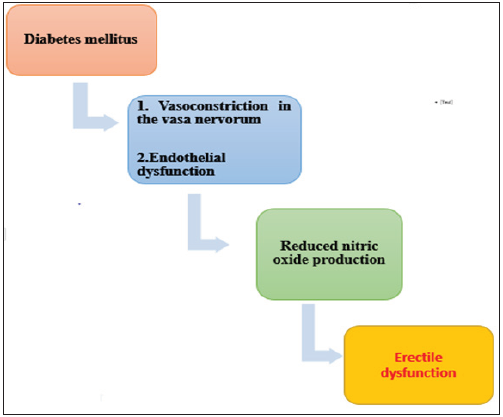
Aim and Objectives
The aim is to do a systematic review of relevant studies on
erectile dysfunction among men with diabetes mellitus in Nigeria.
The specific objectives are to:
1. Determine the prevalence of erectile dysfunction among
Nigerian men with diabetes.
2. Identify the clinical correlates of erectile dysfunction in men
with diabetes.
Methods
Medical data bases were searched for studies on erectile dysfunction in Nigerian men with diabetes. The databases searched were Google Scholar, PubMed, African Journals Online (AJOL), SCOPUS and Web of Science. The terms searched were ‘Erectile dysfunction’, ‘Diabetes’, Nigeria’. Boolean operators such as ‘AND’ as well as ‘OR’ were used as deemed appropriate by the authors. Grey literature was also searched
Inclusion criteria
1. Studies done to determine the prevalence and/or clinical
correlates of erectile dysfunction among Nigerian men with
diabetes published between 1990-2020.
2. Studies whose abstracts and or full text were available at the
searched databases or from the grey literature.
Exclusion criteria
1. Studies on erectile dysfunction whose study population is not
Nigerian men.
2. Studies on erectile dysfunction not focused on diabetic men.
3. Studies whose abstracts or main texts were not available for
review.
The databases were searched independently by the authors
and the included studies were deemed appropriate by at least three
out of the four authors.
Relevant data were extracted and presented in texts, tables and
charts.
Result
Twenty-two studies were retrieved and reviewed but only 12 studies satisfied the stipulated criteria and were adjudged by the authors to be relevant to the subject matter. The studies selected were all cross-sectional studies. The total population in the selected studies was 1777. There are 6 geopolitical zones in Nigeria: North-west, North-central, North-east, South-west, Southsouth and South-east geopolitical zones. The distribution of the studies, using geopolitical zones is shown in Table 2. The table clearly shows that most of the studies on ED among diabetic men in Nigeria were carried out in the southern part of the country with a third of the overall studies done in the South-south geopolitical zone. According to a study done by Uloko et al. [9] the prevalence of diabetes in various geopolitical zones in Nigeria is depicted in Table 3. The Figure 3 is a graphical representation comparing the prevalence of diabetes and the number of studies on ED among Nigerian men with diabetes mellitus. There is a positive but nonstatistically significant correlation between prevalence of diabetes and the number of studies on erectile dysfunction among men with diabetes across various geopolitical zones (p=0.2, r=0.609). Based on the selected studies, the prevalence of erectile dysfunction among Nigerian men with type 2 diabetes is 48.4-98.0%. The prevalence rate in each study is represented in Table 4. International index of erectile function (IIEF-5) questionnaire was used to assess for erectile dysfunction in all the studies. It is a research tool that has been shown to be of acceptable quality in assessing erectile dysfunction [26]. It has been consistently validated and translated into several languages and has been used in scores of clinical trials [27]. Also, it has a high index of sensitivity and specificity. It is a series of 5 questions about sexual function in the past 4 weeks and each question is graded from 0 to 5 [28-30]. A score of less than 22 out of a possible score of 25 is considered as erectile dysfunction. The sample size in each study is shown in Table 5. Predictors of erectile dysfunction in men with diabetes in Nigeria and the various studies in which they were documented are shown in Table 6; [31- 33]. The frequencies of the predictors of erectile dysfunction among Nigerian men with diabetes are represented graphically in Figure 4. The frequencies of confounders as reported in some of the studies recruited into the systematic review are documented in the Table 7.
Figure 3:Comparison of the prevalence of diabetes and the number of studies on ED among Nigerian men with diabetes mellitus across the six geopolitical zones.
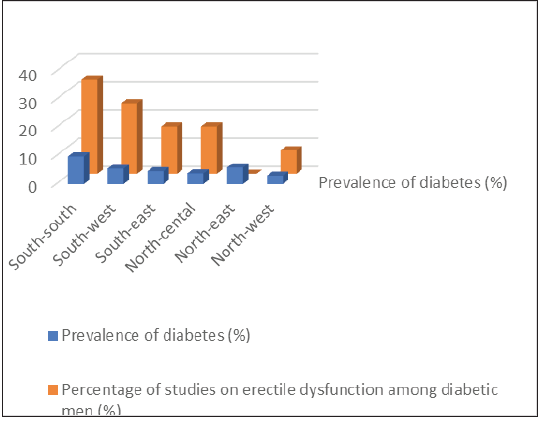
Figure 4:Frequencies of predictors of erectile dysfunction in Nigerian men with diabetes in various studies.

Table 2:Distribution of the studies on erectile dysfunction among Nigerian men with diabetes in various geopolitical zones.

Table 3:Prevalence of diabetes in Nigerian according to the various geopolitical zones.
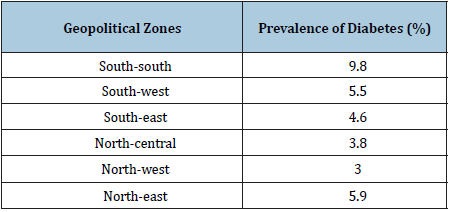
Table 4:Prevalence of erectile dysfunction among Nigerian men with diabetes mellitus in the selected studies.
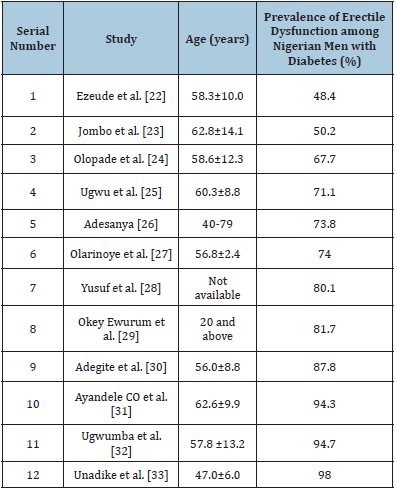
Table 5:Sample size in each of the selected studies.

Table 6:Predictors of erectile dysfunction among Nigerian men with diabetes.

Table 7:Confounders in men with diabetes.
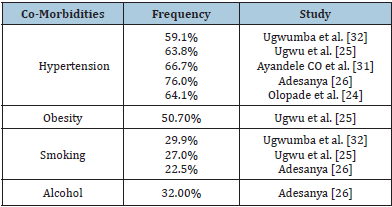
Discussion
The prevalence of erectile dysfunction in Nigerian men with
diabetes ranges from 48.4% to 98%. This wide range in prevalence
is in keeping with a prevalence rate of 27-75% documented by
Bacon and Nisahan [34,35] have also documented a prevalence rate
of ED among men with diabetes to range from 35% to 90% which is
comparable to the present study. The wide range in the prevalence
may be due to differences in demographic characteristics as well
as the methods and study designs adopted in each study. The
prevalence in this systematic review is also in agreement with
a prevalence of 71.5% in a systematic review and meta-analysis
of studies done in various African countries on the prevalence of
erectile dysfunction among men with diabetes mellitus [10]. Oyelade
et al. [14] attributed the high prevalence of erectile dysfunction
among men with diabetes to the presence of vascular disease
and autonomic neuropathy often reported among these patients.
These parameters were also found to be recurrent factors among
Nigerian men with diabetes in various studies selected for this
systematic review. In addition to microvascular and macrovascular
complications that can explain the high prevalence of ED among
men with diabetes, Hurisa et al. [36] in a study done in Ethiopia, a
developing country like Nigeria, a high prevalence of co-morbidities
such as hypertension is also a plausible explanation. This systematic
review also showed a high prevalence of co-morbidities among
men with diabetes. For example, hypertension was present in 59.1-
76.0 of men in Nigeria with diabetes [25,26,31,32]. This may partly
account for the high prevalence of ED in this cohort of patients.
The predictors of erectile dysfunction among Nigerian men with
diabetes include longer duration of diabetes, poor glycaemic control,
older age, peripheral arterial disease, autonomic neuropathy and
obesity. The association between erectile dysfunction and duration
of diabetes has also been demonstrated by other authors. In a
multicentric study involving 1312 Korean men who were being
managed for diabetes, Cho et al., also demonstrated a significant
association between the occurrence of erectile dysfunction among
diabetic men and the duration of the diabetes [37]. Furthermore,
in a prospective study conducted in a tertiary health facility in
Shaanxi Province, China, a group of researchers reported that
the longer the duration of diabetes, the higher the prevalence of
erectile dysfunction among the subjects [38]. This occurs as a result
of the neuropathic and angiopathic mechanisms underlying erectile
dysfunction having enough time to develop and manifest clinically
[32]. Poor glycaemic profiles, both short term and especially
long-term control, have been shown to positively correlate with
the prevalence of erectile dysfunction among men with diabetes,
as shown in this systematic review. In another systematic
review involving 5 cross-sectional studies and 3299 patients,
Binmoammar et al. [39], reported a significant association between
poor glycaemic control and prevalence of erectile dysfunction in
men with diabetes. In a cross-sectional descriptive study involving
217 men in Northern Pakistan, prevalence of erectile dysfunction
was shown to be higher with poor glycaemic control [40]. Poor
glycaemic control is associated with microvascular complications
especially neuropathy which is reported to be a major underlying
pathogenetic factor for erectile dysfunction in men with diabetes
[32]. As similarly reported in this systematic review, several
population studies have also reported a high prevalence of ED in
the older population. Pallangyo [41] independently demonstrated
in community studies in Nigeria and Tanzania respectively a
higher prevalence of ED with advancing age [42]. Increasing
age is associated with rising prevalence of disorders such as
hypertension and decreased general physiological reserve thereby
mediating the reportedly higher prevalence of ED in the older men.
Peripheral arterial disease has also been found to be significantly
associated with erectile dysfunction. In a study involving 690 men,
Polonsky et al. [43] demonstrated a significant association between
peripheral arterial disease and erectile dysfunction. Diabetes is a
common pathological intermediate in the development of both
erectile dysfunction and peripheral arterial disease. Microvascular
complications mediate the autonomic neuropathy responsible for
erectile dysfunction in men with diabetes mellitus. Obesity has also
been demonstrated to be independently associated with erectile
dysfunction in patients with diabetes [32].
Conclusion
There is scanty literature on erectile dysfunction among Nigerian men with diabetes mellitus hence the need to have a systematic review to provide composite information on the topic. The few studies on erectile dysfunction among Nigerian men with diabetes were done across different geopolitical zones but more studies were done in Southern Nigeria. Therefore, there is a need to conduct more studies across all zones and more especially in the Northern part of the country. The prevalence of erectile dysfunction among Nigerian men with diabetes is 48.4-98.0%. The wide range reflects differences in demographics and research designs. The main predictors of erectile dysfunction among Nigerian men with diabetes are longer duration of diabetes, poor glycaemic control, older age, peripheral arterial disease, autonomic neuropathy and obesity.
Limitations of the study
1. Most of the studies were hospital-based studies so the
application to the general community may require slight
caution.
2. The number of studies that met the eligibility criteria was
rather scanty.
References
- Kharroubi AT, Darwish HM (2015) Diabetes mellitus: The epidemic of the century. World J Diabetes 6(6): 850-867.
- Misra A, Gopalan H, Jayawardena R, Hills AP, Soares M, et al. (2019) Diabetes in developing countries. J Diabetes 11(7): 522-539.
- Sabir AA, Balarabe S, Sani AA, Isezuo A, Bello KS, Jimoh AO, et al. (2017) Prevalence of diabetes mellitus and its risk factors among the suburban population of Northwest Nigeria. Sahel Med J 20(4): 168-172.
- Kinnear TW (1963) The pattern of diabetes mellitus in a Nigerian teaching hospital. East Afr Med J 40: 288-294.
- Osuntokun BO, Akinkugbe FM, Francis TI, Reddy S, Osuntokun O, et al. (1971) Diabetes mellitus in Nigerians: A study of 832 patients. West Afr Med J Niger Pract 20(5): 295-312.
- Ohwovoriole AE, Kuti JA, Kabiawu SI (1988) Casual blood glucose levels and prevalence of undiscovered diabetes mellitus in Lagos Metropolis Nigerians. Diabetes Res Clin Pract 4(2): 153-158.
- Olatunbosun ST, Ojo PO, Fineberg NS, Bella AF (1998) Prevalence of diabetes mellitus and impaired glucose tolerance in a group of urban adults in Nigeria. J Natl Med Assoc 90(5): 293-301.
- Dahiru T, Aliyu AA, Shehu AU (2016) A review of population-based studies on diabetes mellitus in Nigeria. Sub-Saharan Afr J Med 3: 59-64.
- Uloko AE, Musa BM, Ramalan MA, Gezawa ID, Pueppet FH, et al. (2018) Prevalence and risk factors for diabetes mellitus in Nigeria: a systematic review and meta-analysis. Diabetes Ther 9(3): 1307-1316.
- Shiferaw WS, Akalu TY, Asmare Y (2020) Prevalence of erectile dysfunction in patients with diabetes mellitus and its association with body mass index and glycated hemoglobin in Africa: A systematic review and meta-analysis. Int J Endocrinol 2020: 5148370.
- Mobley DF, Khera M, Baum N (2016) Recent advances in the treatment of erectile dysfunction. Postgraduate Med J 93(1105): 134073.
- Miorino MI, Bellastella G, Esposito K (2014) Diabetes and sexual dysfunction: current perspective. Diabetes Metab Syndr Obes 7: 95-105.
- Dong JY, Zhang YH, Qin LQ (2011) Erectile dysfunction and risk of cardiovascular disease: Meta-analysis of prospective cohort studies. J Am Coll Cardiol 58(13): 1378-1385.
- Oyelade BO, Jemilohun AC, Aderibigbe SA (2016) Prevalence of erectile dysfunction and possible risk factors among men of south-western Nigeria: a population-based study. PanAfrican Med J 24: 124.
- Idung AU, Abasiubong F, Ukot IA, Udoh SB, Unadike BC (2012) Prevalence and risk factors of erectile dysfunction in the Niger Delta, Nigeria. Afr Health Sci 12(2): 160-165.
- Olugbenga Bello AI, Adeoye OA, Adeomi AA, Olajide AO (2013) Prevalence of erectile dysfunction (ED) and its risk factors among adult men in a Nigerian community. Niger Postgrad Med J 20(2): 130-135
- Takure AO, Adebayo SA, Okeke LI, Olaopa EO, Shittu OB (2016) Erectile dysfunction among men attending surgical out-patients departments in a tertiary hospital in south-western Nigeria. Niger J Surg 22(1): 32-36.
- Abu S, Atim T, Ripiye NR Prevalence of erectile dysfunction and awareness of its treatment in Abuja, Nigeria. Int J Trop Dis Health 37(3): 1-10.
- Thorve VS, Kshirsagar AD, Vyawahare NS, Joshi VS, Ingale KG, et al. (2011) Diabetes-induced erectile dysfunction: epidemiology, pathophysiology and management. Diabetes Complications 25(2): 129-136.
- Gratzke C, Angulo J, Chitaley K, Dai YT, Kim NN, et al. (2010) Anatomy, physiology, and pathophysiology of erectile dysfunction. J Sex Med 7(1 Pt 2): 445-475.
- Hurt KJ, Musicki B, Palese MA, Crone JK, Becker RE, et al. (2002) Akt-dependent phosphorylation of endothelial nitric-oxide synthase mediates penile erection. Proc Natl Acad Sci USA 99: 4061-4066.
- Ezeude CM, Ezeude AM, Young EE, Oguejiofor OC, Adamu AG (2020) Correlates of erectile dysfunction in Nigerian men with type 2 diabetes mellitus: experience from a tertiary health centre. J Diabetes Mellit 10(3): 103105.
- Jombo HE, Onung SI, Idung SO, Iyanam VE (2020) Erectile dysfunction and depression in males with type 2 diabetes mellitus in a tertiary healthcare facility in Uyo, South-south Nigeria. Asian J Med Princ Clin Pract 3(1): 9-17.
- Olopade O, Kadijat M, Nwaukwa P, Udo C, Okunowo B, et al. (2018) Frequency and predictors of sexual dysfunctions among male Nigerians with diabtetes mellitus (a preliminary report). Endocrine Abstracts 59: 097.
- Ugwu T, Ezeani I, Onung S, Kolawole B, Ikem R (2016) Predictors of erectile dysfunction in men with type 2 diabetes mellitus referred to a tertiary healthcare centre. Adv Endocrinol 2016: 9753154.
- Adesanya AO (2010) Erectile dysfunction in Nigeria males with type 2 diabetes mellitus. A dissertation submitted to the Nigeria Postgraduate Medical College. Unpublished.
- Olarinoye JK, Kuranga SK, Katibi IA, Adediran OS, Jimoh AA, et al. (2006) Prevalence and determinants of erectile dysfunction among people with type 2 diabetes in Ilorin, Nigeria. Niger Postgrad Med J 13(4): 291-296.
- Yusuf BO, Fasanmade OA, Sada KB, Sabir AA (2008) Erectile dysfunction among diabetes mellitus patients in Sokoto, Nigeria: Patients’ perspectives. 40th Annual General Meeting of the Endocrinology and Metabolism Society of Nigeria. Unpublished.
- Okey Ewurum IG, Amadi AN, Nwoke EA, Amadi COA, Ibe SNO, et al. (2020) Association of erectile dysfunction with systemic hypertension and diabetes mellitus in Rivers state, Nigeria. Int J Res Rev 7(6): 465-470.
- Adegite A, Aniekwensi E, Ohihoin A (2009) The prevalence of erectile dysfunction and its demographic and lifestyle correlates among male type 2 diabetics in Jos, Nigeria. Endocrine Abstracts 19: 157.
- Ayandele CO, Anizor C, Owolabi FA, Yusuff OT, Ajiboye JK, et al. (2016) Erectile dysfunction among male type 2 diabetics in a South-western teaching hospital, Nigeria. Endocrine Abstracts 44: 96.
- Ugwumba FO, Okafor CI, Nnabugwu II, Udeh EI, Echetabu KN, et al. (2018) Prevalence of, and risk factors for erectile dysfunction in male type 2 diabetic outpatient attendees in Enugu, South east Nigeria. Ann Afr Med 17(4): 215-220.
- Unadike BC, Eregie A, Ohwovoriole AE (2008) Prevalence and types of sexual dysfunction among males with diabetes in Nigeria. Afr J Diabetes Med 2008: 18-20.
- Bacon CG, Hu FB, Giovannucci E, Glasser DB, Mittleman MA, et al. (2002) Association of type and duration of diabetes with erectile dysfunction in a large cohort of men. Diabetes Care 25(8): 1458-1463.
- Nisahan B, Kumanan T, Rajeshkannan N, Penarantharajan T, Aravinthan N (2019) Erectile dysfunction and associated factors among men with diabetes mellitus from a tertiary diabetic centre in Northern Sri Lanka. BMC Res Notes 12(1): 210.
- Hurisa AD, Negera GZ (2020) Erectile dysfunction among diabetic patients in a tertiary hospital of southwest Ethiopia. Open Public Health J 13: 240-245.
- Cho NH, Ahn CW, Park JY, Ahn TY, Lee HW, et al. (2006) Prevalence of erectile dysfunction in Korean men with type 2 diabetes mellitus. Diabet Med 23(2): 198-203.
- Chaudhary RK, Shamsi BH, Tan T, Chen HM, Xing JP (2016) Study of the relationship between male erectile dysfunction and type 2 diabetes mellitus/metabolic syndrome and its components. J Int Med Res 44(3): 735-741.
- Binmoammar TA, Hassounah S, Alsaad S, Rawaf S, Majeed A (2016) The impact of poor glycaemic control on the prevalence of erectile dysfunction in men with type 2 diabetes mellitus: A systematic review. J R Soc Med Open 7: 1-10.
- Ahmed I, Aamir AZ, Anwar E, Ali SS, Ali A, et al. (2013) Erectilee dysfunction and type 2 diabetes mellitus in Northern Pakistan. J Pak Med Assoc 63: 1486-1490.
- Pallangyo P, Nicholaus P, Kisenge P, Mayala H, Swai N, et al. (2016) A community-based study on prevalence and correlates of erectile dysfunction among Kinondoni district residents, Dar es Salaam, Tanzania. Reprod Health 13(1): 140.
- Rosen RC, Cappalleri JC, Gendrano NR (2002) International Index of Erectile Function (IIEF): A state-of-the-science review. Int J Impotence Res 14(4): 226-244.
- Polonsky TS, Taillon LA, Sheth H, Min JK, Archer SL, et al. (2009) The association between erectile dysfunction and peripheral arterial disease as determined by screening ankle brachial index testing. Atherosclerosis 207: 440-444.
© 2020 Taoreed Adegoke Azeez. This is an open access article distributed under the terms of the Creative Commons Attribution License , which permits unrestricted use, distribution, and build upon your work non-commercially.
 a Creative Commons Attribution 4.0 International License. Based on a work at www.crimsonpublishers.com.
Best viewed in
a Creative Commons Attribution 4.0 International License. Based on a work at www.crimsonpublishers.com.
Best viewed in 







.jpg)






























 Editorial Board Registrations
Editorial Board Registrations Submit your Article
Submit your Article Refer a Friend
Refer a Friend Advertise With Us
Advertise With Us
.jpg)






.jpg)














.bmp)
.jpg)
.png)
.jpg)










.jpg)






.png)

.png)



.png)






